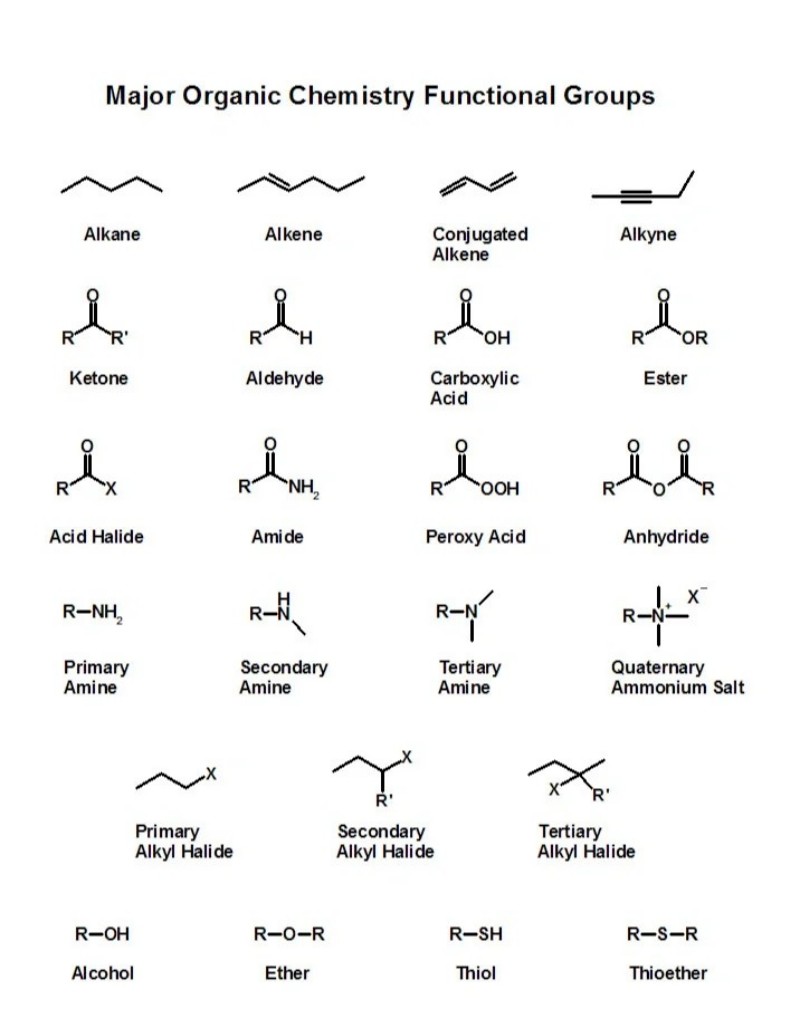Katika kemia, haswa katika kemia ya kikaboni, kikundi cha kazi ni kikundi maalum cha atomi ndani ya molekuli ambayo inawajibika kwa athari za kemikali za tabia ya molekuli. Ifikirie kama "tovuti inayotumika" au "sehemu ya kufafanua tabia" ya molekuli ya kikaboni. Haijalishi ukubwa au umbo la molekuli nyingine ni nini, kikundi kinachofanya kazi kinatenda kwa njia inayotabirika katika athari za kemikali.
Kwa Nini Vikundi vya Utendaji Ni Muhimu?
Vikundi vya kazi huamua mali na reactivity ya misombo ya kikaboni. Wanakemia huzitumia kuainisha molekuli za kikaboni na kutabiri jinsi zitakavyofanya. Kwa mfano, alkoholi, asidi, esta, na ketoni zote zina vikundi tofauti vya utendaji, na kila humenyuka kwa njia tofauti katika athari za kemikali.
Kwa kutambua vikundi vya utendaji katika molekuli, unaweza:
● Bashiri jinsi itakavyokuwa katika athari za kemikali.
● Elewa umumunyifu wake (kama inayeyuka kwenye maji au la).
● Amua ikiwa ni tindikali au msingi.
● Tabiri kiwango chake cha kuchemka au kuyeyuka.
Mifano ya Vikundi vya Utendaji vya Kawaida
Wacha tuchunguze baadhi ya vikundi vya utendaji vya kawaida katika kemia ya kikaboni:
1. Kikundi cha Hydroxyl (-OH)
● Hupatikana katika vileo.
● Hufanya molekuli polar na zenye uwezo wa kutengeneza vifungo vya hidrojeni.
● Mfano: Ethanoli (CH₃CH₂OH)
2. Kikundi cha Carbonili (C=O)
● Hupatikana katika ketoni na aldehaidi.
● Kaboni iliyounganishwa mara mbili kwenye atomi ya oksijeni.
● Mfano:
Ketone: asetoni (CH₃COCH₃)
Aldehyde: Formaldehyde (HCHO)
3. Kikundi cha Carboxyl (-COOH)
● Inapatikana katika asidi ya kaboksili.
● Hufanya molekuli kuwa na tindikali.
● Mfano: Asidi ya asetiki (CH₃COOH), asidi kuu katika siki.
4. Kikundi cha Amino (-NH₂)
● Hupatikana katika amini na amino asidi.
● Inaweza kufanya kama msingi na kukubali protoni.
● Mfano: Glycine, asidi ya amino.
5. Kikundi cha Ester (-COO-)
● Inapatikana katika esta.
● Mara nyingi huwapa matunda harufu zao tamu.
● Hutengenezwa kutokana na asidi na pombe.
● Mfano: Ethyl acetate (inatumika katika kiondoa rangi ya kucha).
6. Kikundi cha Etha (ROR)
● Atomu ya oksijeni iliyounganishwa na vikundi viwili vya kaboni.
● Kawaida katika vimumunyisho.
● Mfano: Diethyl etha.
7. Kikundi cha Halide (CX)
● Ambapo X = halojeni kama F, Cl, Br, au I.
● Imepatikana katika halidi za alkili.
● Hutumika katika friji na vizuia moto.
8. Kikundi cha Sulfhydryl (-SH)
● Inapatikana katika thiols.
● Sawa na hidroksili lakini yenye salfa.
● Muhimu katika muundo wa protini (vifungo vya disulfide).
Vikundi vya Utendaji na Utendaji tena
Uwepo wa kikundi maalum cha utendaji katika molekuli kwa kiasi kikubwa huamua jinsi molekuli hiyo itafanya. Kwa mfano:
● Pombe (-OH) zinaweza kupungukiwa na maji ili kuunda alkene.
● Asidi za kaboksili (-COOH) zinaweza kuitikia pamoja na alkoholi kuunda esta.
● Amines (-NH₂) inaweza kufanya kazi kama besi na kukubali ayoni za hidrojeni.
Tabia hii ya kutabirika ni muhimu sana katika kemia sanisi, muundo wa dawa na sayansi ya nyenzo.
Vikundi Vitendaji katika Molekuli za Kibiolojia
Vikundi vinavyofanya kazi pia ni muhimu kwa maisha. Katika biokemia, muundo na kazi ya protini, DNA, wanga, na mafuta hutegemea sana vikundi vya kazi vilivyomo.
● Protini huwa na vikundi vya amino (-NH₂) na kaboksili (-COOH).
● Wanga mara nyingi huwa na vikundi vya haidroksili (-OH) na kabonili (C=O).
● DNA na RNA zina vikundi vya fosfeti (-PO₄) na besi zilizo na nitrojeni.
Vikundi hivi huruhusu molekuli za kibaolojia kuingiliana, kuunda vifungo vya hidrojeni, nishati ya uhamisho, na zaidi.
Jinsi Wanakemia Wanavyotumia Vikundi Vitendaji
Wanakemia mara nyingi hutumia nukuu za kikundi tendaji wakati wa kuchora au kutaja molekuli. Katika athari za kemikali, zinaweza kurejelea athari za kikundi kinachohusika. Kwa mfano:
● “Uoksidishaji wa pombe” hurejelea miitikio inayohusisha vikundi vya -OH.
● "Ubadilishaji wa nukleofili" mara nyingi huhusisha vikundi vya utendaji wa halidi.
Pia hutumia uchanganuzi wa kikundi unaofanya kazi ili kutambua misombo isiyojulikana kwa kutumia mbinu kama vile uchunguzi wa infrared (IR) na resonance ya sumaku ya nyuklia (NMR), kwa kuwa kila kikundi kinafyonza nishati kwa njia ya kipekee.
Muhtasari
Kikundi kinachofanya kazi ni kikundi maalum cha atomi katika molekuli ambayo huipa molekuli sifa zake maalum na utendakazi tena. Wao ni msingi wa kemia ya kikaboni, kutoa njia ya kuainisha na kutabiri tabia ya molekuli tata. Kutoka kwa alkoholi rahisi hadi DNA changamano, vikundi vya utendaji husaidia kufafanua muundo, kazi, na utendakazi wa misombo ya kemikali. Kuzielewa ni muhimu katika ujuzi wa kemia, hasa katika maeneo kama dawa, biolojia, na kemia ya viwanda.
Muda wa kutuma: Juni-20-2025






